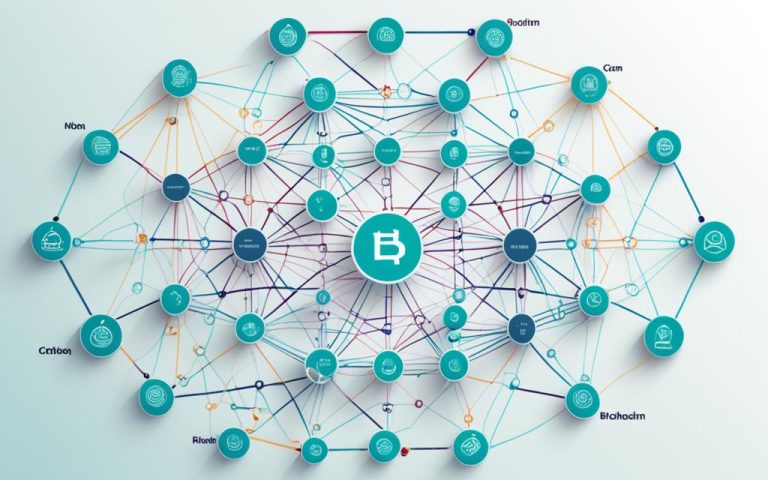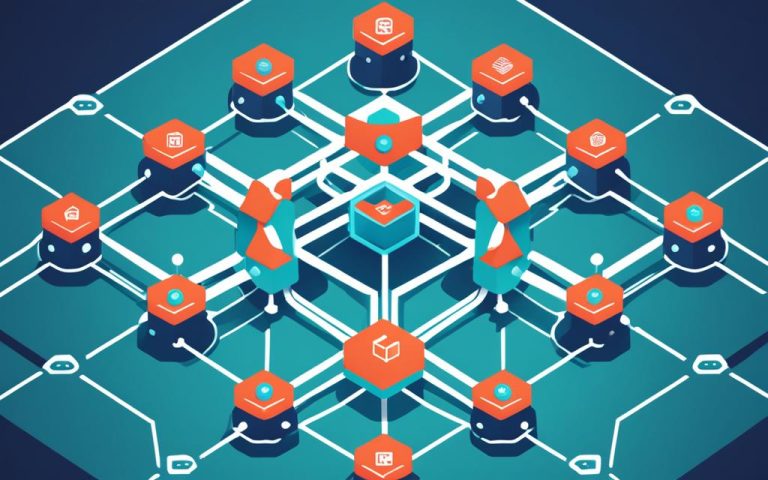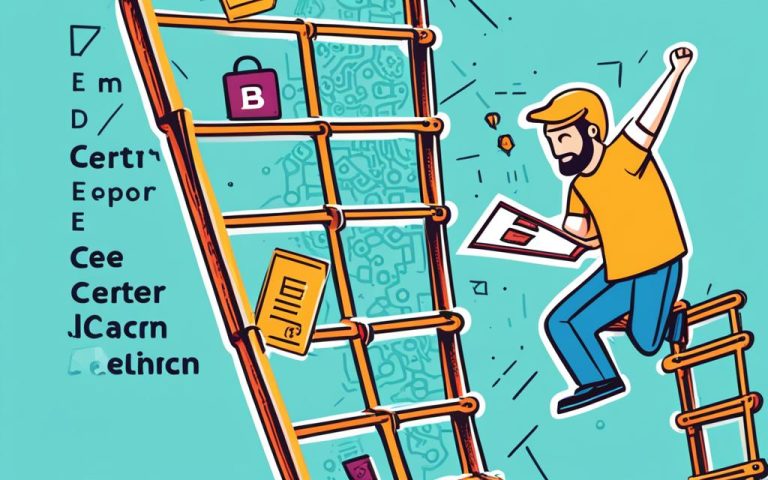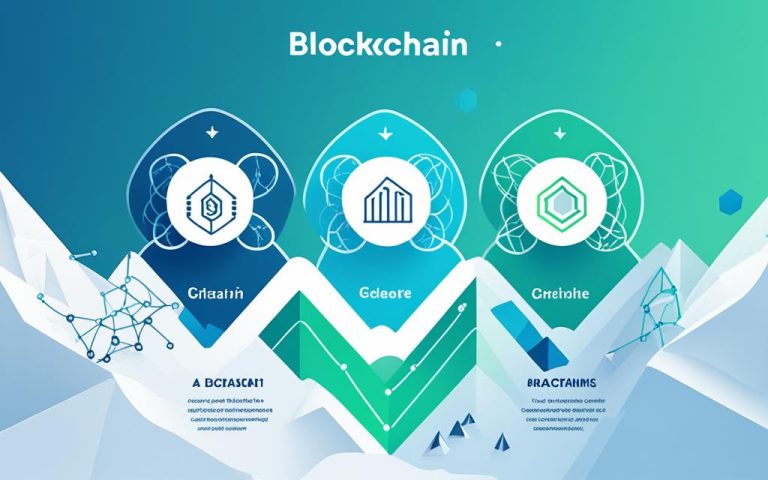Building a blockchain solution needs good planning and action. This guide outlines steps for developing blockchain for your business.
First, identify a problem that needs solving. Then, draft business requirements. Choose a consensus mechanism after that. Selecting a blockchain platform is next.
Designing blockchain nodes is another step. Then, plan the blockchain’s setup. Building APIs follows this. Finally, design the user interface.
Each step is important for the development journey. They require deep research and thinking about your business needs. By using this guide, you’ll start tapping into blockchain’s possibilities.
Understanding How Blockchain Works
Blockchain technology is changing our world. It’s important to learn its building blocks for a clear view. Let’s dive into what makes it unique and useful in many fields.
At its core, blockchain is like a digital book for recording information. It uses data blocks linked together, creating a digital ledger. Each block records transactions, who owns what, or other key info.
Blockchain is different because it doesn’t use a central system to keep records. Instead, it spreads its data across many computers. This makes everything open, yet secure, and impossible to change wrongly.
A critical part of blockchain is its consensus mechanism. It helps everyone agree on transactions without needing trust. There are many types, like proof of work or proof of stake. The choice depends on what’s needed from the blockchain.
Every block connects to the one before it with a hash. This unique code keeps the order and makes changing old blocks noticeable. Miners check each transaction, ensuring everything is correct and true.
Picking the right blockchain platform matters a lot when making blockchain apps. You need to consider things like how well it can grow, its privacy, and security. Also, think about the support from users and if it works with your coding language.
| Platform Name | Consensus Mechanism | Scalability | Privacy Features | Community Support | Language Compatibility |
|---|---|---|---|---|---|
| Ethereum | Proof of Stake | High | Basic | Large and Active | Solidity |
| Hyperledger Fabric | Byzantine Fault-Tolerant (BFT) | High | Advanced | Enterprise-focused | Go, JavaScript, Java |
| Corda | Pluggable Consensus | Medium | Advanced | Enterprise-focused | Java, Kotlin |
| Stellar | Federated Byzantine Agreement (FBA) | High | Basic | Financial Institutions | JavaScript |
Understanding blockchain is key for those wanting to use this tech. By knowing about decentralization, how data blocks work, consensus, and choosing platforms, you can explore blockchain’s benefits fully.
Advantages and Disadvantages of Blockchain Technology
Blockchain technology brings many benefits. It offers transparency with its public ledger, allowing all users to track transactions. This builds trust and teamwork. It also makes auditing and tracking easy. This helps a lot in managing supply chains to stop fraud.
The tech is secure due to its decentralized and coding nature. Once data is on the blockchain, changing it is very hard. This ensures that the information stays true. So, industries needing strong data protection find blockchain very appealing.
Blockchain cuts out middlemen, allowing peer-to-peer transactions. This can lower costs and boost efficiency. Companies can improve their services, helping them save money and earn more.
Blockchain also improves traceability and auditability. Each transaction connects to the one before it. This creates a clear, uninterrupted chain of data. It’s very useful in supply chains for checking product authenticity and origin.
But, blockchain isn’t perfect and faces some problems. One issue is the complexity of changing data. To make changes, you need to rewrite the code in all blocks, which is hard and costly.
There’s also a problem with scalability. The tech can only handle a limited amount of data per block. As transactions grow, blockchain might struggle to keep up.
Due to its decentralized design, blockchain faces legal challenges. Different laws and regulations affect its use, especially in finance. Issues around settling disputes and meeting legal standards are tricky.
The technology can also use a lot of power, especially in the mining process. This can lead to high costs and environmental damage. Some public blockchains need lots of computing power and energy.
Since blockchain is fairly new, some people might not trust it yet. The age of the technology can affect how quickly people accept it.
For more information on blockchain technology’s pros and cons, check out these sites:
Conclusion
Blockchain technology is changing how businesses work, touching on many areas. These include banks, government, health care, online shopping, real estate, law, digital money, and tech industries. By learning how blockchain operates and facing its challenges, companies can gain many advantages.
Blockchain brings clearness, trust, safety, lower costs, and better speed. For example, HSBC’s Global Payments cut down the time to process documents from 5-10 days to just 24 hours with blockchain. Estonia uses it to keep public service records safe and improve e-governance. De Beers uses blockchain to keep track of diamonds for clarity, and Sweden tried it for quicker property deals.
Blockchain’s uses are growing in fields like finance, supply management, health care, and voting. It extends from blockchain wallets and smart agreements to decentralized apps and asset token platforms. This opens up many new opportunities.
For a blockchain project to do well, planning, picking the best blockchain platform, and following legal rules are key steps. Testing, making sure of quality, and regular upkeep are important to keep things working well, reliably, and safely. Being open to new tech like DeFi and NFTs helps companies keep up in the blockchain area.
Rejolut has a lot of experience, having worked on over 50 blockchain ventures. They offer quick strategy workshops and design frameworks. These approaches are like those used in successful projects like Ethereum, Solana, and Hedera. Their Rapid Prototyping Framework (RPF) helps companies quickly take an idea to the development stage. This reduces risks by spotting issues in concepts and business plans early.
Staying up-to-date, embracing innovation, and using the skills of firms like Rejolut can guide companies through blockchain development. This lets them fully use blockchain to bring about innovation and growth.
FAQ
How can I develop a blockchain solution for my business?
To develop a blockchain for your business, start with a plan. Use our guide for step-by-step help. It covers everything from spotting a problem to solving it. This includes your business needs, picking a platform, and designing user interfaces.
What is blockchain and how does it work?
Blockchain is a tech that spreads data across many computers. It’s like a digital book that keeps records in order. Each new piece of data gets reviewed, then added. And, all the pieces are locked together in a safe way. This tech relies on everyone agreeing, which makes it secure and trustworthy.
What are the advantages and disadvantages of blockchain technology?
Blockchain has great benefits like security and saving money. It lets everyone see the same records, which builds trust. But, it’s not perfect. It can be complex and slow, uses lots of power, and sometimes doesn’t talk well with other systems.
What are the key challenges and benefits of developing blockchain?
Making blockchain can change the game for businesses. It brings trust, keeps things secure, cuts costs, and speeds things up. Yet, facing its complexity, scaling issues, and how much energy it uses can be tough. Still, it’s making waves in finance, supply chains, and healthcare.



















